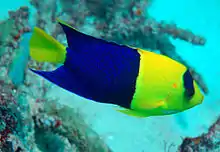Bicolor angelfish
The bicolor angelfish (Centropyge bicolor) is a marine species of fish, easily recognizable by its yellow tail, yellow front half of their body, and blue rear with blue patterns above and around the eye. This angelfish is also commonly known as: Pacific rock beauty, oriole angelfish, oriole dwarf angel, blue and gold angel, and two-colored angel.[3] The average life expectancy is 5–13 years, depending upon its location.[4] These fish tend to grow to a maximum of 6 inches in length, making them a dwarf fish.[3]
| Bicolor angelfish | |
|---|---|
 | |
| Scientific classification | |
| Kingdom: | Animalia |
| Phylum: | Chordata |
| Class: | Actinopterygii |
| Order: | Perciformes |
| Family: | Pomacanthidae |
| Genus: | Centropyge |
| Species: | C. bicolor |
| Binomial name | |
| Centropyge bicolor (Bloch, 1787) | |
| Synonyms[2] | |
|
Chaetodon bicolor Bloch, 1787 | |
Distribution and habitat
The bicolor angelfish species is most commonly found in the Indo-Pacific region: including East Africa, southern Japan, Australia, and Fiji.[5] They live at depths ranging from 1 to 25 meters. Common habitats include reef slopes, coral areas, lagoons, and near drop-off areas.[2]
Biology
A typical bicolor angelfish diet consists of small crustaceans, such as brine and mysis shrimp, as well as tunicates, corals, sponges, worms, algae, and sometimes clams.[3] This is a non-migratory species that lives in harems with a single linear hierarchy based on size.[3][6] Mature adults are identified based on size. Males and females have no color distinction.
Reproduction
Male bicolor angelfish visit the homes of females at dusk to mate. One male may visit one or multiple females per night to spawn. A female will scatter her eggs, and a male will release sperm that will fertilize the egg.[7] Females, however, can only spawn a maximum of once per day. Higher-ranking females have been found to spawn more frequently than lower-ranked females.
They live in harems, meaning several female share one male for mating. Most harems of this species consist of an average of 7 females, ranked in order of size, who mate with one male. The male is the dominant individual of the group, with each female decreasingly ranked based upon decreasing size. They are protogynous hermaphrodites, meaning if the male is removed or dies, the highest ranking female will undergo a sex change. This sex change lasts 18–20 days total.[2]
Behavior
Centropyge bicolor tend to be moderately aggressive, both to members of other species and members of their own species—even their own group. The male spends most of his time guarding his territory from predators, intruding members of other species, but mostly against another harem. This territory tends to be a maximum of 200m2 and encompasses the home ranges of all females within the group. Females are only aggressive towards lower-ranking members of their own group, in order to maintain their current rank.[6]
In aquaculture
Because bicolor angelfish are classified as aggressive fish, they require a larger tank size, at least 75 gallons. They do not survive well in captivity and are not well suited for a reef aquarium.[8] They are best suited for a tank consisting of coral, rocks and plants.[9] Tanks with the most amount of hiding spaces are best, as they like to move from one hiding place to another.[10] The best water temperature for fish in captivity is typically between 72-78F. An optimal pH level is between 8.1-8.4. The level of care these fish require is moderate.[11] These fish will survive best if there are no other fish species present within the same tank. It is recommended that bicolor angelfish in captivity be fed algae, shrimps, worms, and spirulina flakes.[12]
References
- Pyle, R.; Myers, R. & Rocha, L.A. (2010). "Centropyge bicolor". IUCN Red List of Threatened Species. 2010: e.T165902A6161394. doi:10.2305/IUCN.UK.2010-4.RLTS.T165902A6161394.en. Retrieved 20 December 2020.
- Froese, Rainer and Pauly, Daniel, eds. (2019). "Centropyge bicolor" in FishBase. December 2019 version.
- Depriest, Brian, et al. “Bicolor Angelfish.” SaltwaterFish, 2 Aug. 2014, www.saltwaterfish.com/product-bicolor-angelfish-a
- Aldenhoven, J. M. “Local variation in mortality rates and life-Expectancy estimates of the coral-Reef fish Centropyge bicolor (Pisces: Pomacanthidae).” SpringerLink, Springer-Verlag, 4 Apr. 1986, link.springer.com/article/10.1007/BF00392841
- Herrera, M., et al. “Development of polymorphic microsatellite loci for conservation genetic studies of the coral reef fish Cetropyge bicolor.” Journal of Fish Biology, Blackwell Publishing Ltd, 14 Aug. 2015, http://onlinelibrary.wiley.com/doi/10.1111/jfb.12694/full
- Ang, Tzo Zen, and Andrea Manica. “Benefits and Costs of Dominance in the Angelfish Centropyge bicolor.” Ethology, Blackwell Publishing Ltd, 14 June 2010, http://onlinelibrary.wiley.com/doi/10.1111/j.1439-0310.2010.01798.x/full
- “Egg Scattering.” Fish Breeding Strategies, https://fishbreedingstrategies.weebly.com/egg-scattering.html
- Animal-World. “Bicolor Angelfish.” Animal World, http://animal-world.com/encyclo/marine/angels/bicolor.php
- “Bicolor Angelfish.” Animal Planet, 15 May 2012, http://www.animalplanet.com/pets/bicolorangel/
- Centropyge bicolor (Bloch, 1787). Bicolor Angelfish. Discover Life, http://www.discoverlife.org/20/q?search=Centropyge+bicolor
- Centropyge bicolor – Bicolor Angelfish, http://www.marinecompatibilityguide.com/centropygebicolor
- “Bicolor Angelfish.” Bicolor Angelfish, http://www.aquaticcommunity.com/Marine-angelfish/Bicolor.php
External links
- Bicolor Angelfish at Centropyge.net
- Bicolor Angelfish at Fishlore.com
- Photos of Bicolor angelfish on Sealife Collection
